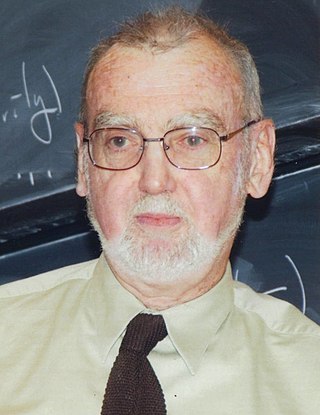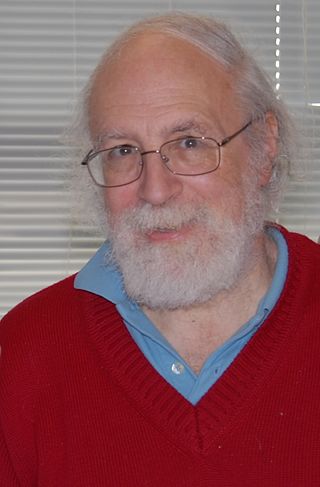Related Research Articles

Robert Phelan Langlands, is a Canadian mathematician. He is best known as the founder of the Langlands program, a vast web of conjectures and results connecting representation theory and automorphic forms to the study of Galois groups in number theory, for which he received the 2018 Abel Prize. He was an emeritus professor and occupied Albert Einstein's office at the Institute for Advanced Study in Princeton, until 2020 when he retired.
In representation theory and algebraic number theory, the Langlands program is a web of far-reaching and influential conjectures about connections between number theory and geometry. Proposed by Robert Langlands, it seeks to relate Galois groups in algebraic number theory to automorphic forms and representation theory of algebraic groups over local fields and adeles. Widely seen as the single biggest project in modern mathematical research, the Langlands program has been described by Edward Frenkel as "a kind of grand unified theory of mathematics."
In mathematics, the Ramanujan conjecture, due to Srinivasa Ramanujan (1916, p.176), states that Ramanujan's tau function given by the Fourier coefficients τ(n) of the cusp form Δ(z) of weight 12

Ilya Piatetski-Shapiro was a Soviet-born Israeli mathematician. During a career that spanned 60 years he made major contributions to applied science as well as pure mathematics. In his last forty years his research focused on pure mathematics; in particular, analytic number theory, group representations and algebraic geometry. His main contribution and impact was in the area of automorphic forms and L-functions.
In mathematics, the local Langlands conjectures, introduced by Robert Langlands, are part of the Langlands program. They describe a correspondence between the complex representations of a reductive algebraic group G over a local field F, and representations of the Langlands group of F into the L-group of G. This correspondence is not a bijection in general. The conjectures can be thought of as a generalization of local class field theory from abelian Galois groups to non-abelian Galois groups.

Roger Evans Howe is the William R. Kenan, Jr. Professor Emeritus of Mathematics at Yale University, and Curtis D. Robert Endowed Chair in Mathematics Education at Texas A&M University. He is known for his contributions to representation theory, in particular for the notion of a reductive dual pair and the Howe correspondence, and his contributions to mathematics education.
In mathematics, the Jacquet–Langlands correspondence is a correspondence between automorphic forms on GL2 and its twisted forms, proved by Jacquet and Langlands (1970, section 16) in their book Automorphic Forms on GL(2) using the Selberg trace formula. It was one of the first examples of the Langlands philosophy that maps between L-groups should induce maps between automorphic representations. There are generalized versions of the Jacquet–Langlands correspondence relating automorphic representations of GLr(D) and GLdr(F), where D is a division algebra of degree d2 over the local or global field F.
Hervé Jacquet is a French American mathematician, working in automorphic forms. He is considered one of the founders of the theory of automorphic representations and their associated L-functions, and his results play a central role in modern number theory.
In mathematics, the Rankin–Selberg method, introduced by (Rankin 1939) and Selberg (1940), also known as the theory of integral representations of L-functions, is a technique for directly constructing and analytically continuing several important examples of automorphic L-functions. Some authors reserve the term for a special type of integral representation, namely those that involve an Eisenstein series. It has been one of the most powerful techniques for studying the Langlands program.
Freydoon Shahidi is an Iranian American mathematician who is a Distinguished Professor of Mathematics at Purdue University in the U.S. He is known for a method of automorphic L-functions which is now known as the Langlands–Shahidi method.
In mathematics, the Langlands–Shahidi method provides the means to define automorphic L-functions in many cases that arise with connected reductive groups over a number field. This includes Rankin–Selberg products for cuspidal automorphic representations of general linear groups. The method develops the theory of the local coefficient, which links to the global theory via Eisenstein series. The resulting L-functions satisfy a number of analytic properties, including an important functional equation.
In mathematics, an automorphic L-function is a function L(s,π,r) of a complex variable s, associated to an automorphic representation π of a reductive group G over a global field and a finite-dimensional complex representation r of the Langlands dual group LG of G, generalizing the Dirichlet L-series of a Dirichlet character and the Mellin transform of a modular form. They were introduced by Langlands.
In mathematics, base change lifting is a method of constructing new automorphic forms from old ones, that corresponds in Langlands philosophy to the operation of restricting a representation of a Galois group to a subgroup.
Erez M. Lapid is an Israeli mathematician, specializing in automorphic forms, L-functions, representation theory, and the Selberg–Arthur trace formula.
Daniel Willis Bump is a mathematician who is a professor at Stanford University. He is a fellow of the American Mathematical Society since 2015, for "contributions to number theory, representation theory, combinatorics, and random matrix theory, as well as mathematical exposition".

Stephen James Rallis was an American mathematician who worked on group representations, automorphic forms, the Siegel–Weil formula, and Langlands L-functions.
In mathematics, the Gan–Gross–Prasad conjecture is a restriction problem in the representation theory of real or p-adic Lie groups posed by Gan Wee Teck, Benedict Gross, and Dipendra Prasad. The problem originated from a conjecture of Gross and Prasad for special orthogonal groups but was later generalized to include all four classical groups. In the cases considered, it is known that the multiplicity of the restrictions is at most one and the conjecture describes when the multiplicity is precisely one.
David Soudry is a professor of mathematics at Tel Aviv University working in number theory and automorphic forms.
Dihua Jiang is a professor of mathematics at the University of Minnesota working in number theory, automorphic forms, and the Langlands program.
James Wesley Cogdell is an American mathematician.
References
- ↑ David Ginzburg at the Mathematics Genealogy Project
- ↑ "Prof. David Ginzburg". Tel Aviv University . Retrieved 29 February 2020.
- ↑ J. Cogdell, H. Jacquet, D. Jiang, S. Kudla, (2015), eds. "Steve Rallis (1942–2012)," Journal of Number Theory, 146, 1–3
- ↑ W.T. Gan, Y. Qiu, and S. Takeda (2014) "The Regularized Siegel–Weil Formula (The Second Term Identity) and the Rallis Inner Product Formula," Inventiones Math. 198, 739–831